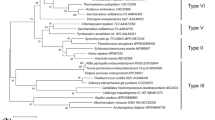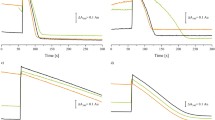Abstract
Flavocytochrome c sulfide dehydrogenase (FCC) is one of the central enzymes of the respiratory chain in sulfur-oxidizing bacteria. FCC catalyzes oxidation of sulfide and polysulfide ions to elemental sulfur accompanied by electron transfer to cytochrome c. The catalytically active form of the enzyme is a non-covalently linked heterodimer composed of flavin- and heme-binding subunits. The Thioalkalivibrio paradoxus ARh1 genome contains five copies of genes encoding homologous FCCs with an amino acid sequence identity from 36 to 54%. When growing on thiocyanate or thiosulfate as the main energy source, the bacterium synthesizes products of different copies of FCC genes. In this work, we isolated and characterized FCC synthesized during the growth of Tv. paradoxus on thiocyanate. FCC was shown to oxidize exclusively sulfide but not other reduced sulfur compounds, such as thiosulfate, sulfite, tetrathionate, and sulfur, and it also does not catalyze the reverse reaction of sulfur reduction to sulfide. Kinetic parameters of the sulfide oxidation reaction are characterized.




Similar content being viewed by others
Abbreviations
- CytC :
-
cytochrome c from horse heart
- FCC:
-
flavocytochrome c sulfide dehydrogenase
- TcDH:
-
thiocyanate dehydrogenase
- TpFCC:
-
flavocytochrome c sulfide dehydrogenase from the bacterium Thioalkalivibrio paradoxus ARh 1
References
Sorokin, D. Y., Berben, T., Melton, E. D., Overmars, L., Vavourakis, C. D., and Muyzer, G. (2014) Microbial diversity and biogeochemical cycling in soda lakes, Extremophiles, 18, 791-809, https://doi.org/10.1007/s00792-014-0670-9.
Sorokin, D. Y., Banciu, H., Robertson, L. A., Kuenen, J. G., Muntyan, M. S., and Muyzer, G. (2013) in The Prokaryotes: Prokaryotic Physiology and Biochemistry (Rosenberg, E., DeLong, E. F., Lory, S., Stackebrandt, E., and Thompson, F., eds) Springer, Berlin, pp. 529-554, https://doi.org/10.1007/978-3-642-30141-4_77.
Sorokin, D. Y., Kuenen, J. G., and Muyzer, G. (2011) The microbial sulfur cycle at extremely haloalkaline conditions of soda lakes, Front. Microbiol., 2, 44, https://doi.org/10.3389/fmicb.2011.00044.
Sorokin, D. Y., and Kuenen, J. G. (2005) Haloalkaliphilic sulfur-oxidizing bacteria in soda lakes, FEMS Microbiol. Rev., 29, 685-702, https://doi.org/10.1016/j.femsre.2004.10.005.
Sorokin, D. Y., Tourova, T. P., Lysenko, A. M., and Kuenen, J. G. (2001) Microbial thiocyanate utilization under highly alkaline conditions, Appl. Environ. Microbiol., 67, 528-538, https://doi.org/10.1128/AEM.67.2.528-538.2001.
Berben, T., Overmars, L., Sorokin, D. Y., and Muyzer, G. (2017) Comparative genome analysis of three thiocyanate oxidizing Thioalkalivibrio species isolated from soda lakes, Front. Microbiol., 8, 254, https://doi.org/10.3389/fmicb.2017.00254.
Berben, T., Balkema, C., Sorokin, D. Y., and Muyzer, G. (2017) Analysis of the genes involved in thiocyanate oxidation during growth in continuous culture of the haloalkaliphilic sulfur-oxidizing bacterium Thioalkalivibrio thiocyanoxidans ARh 2T using transcriptomics, mSystems, 2, e00102-17, https://doi.org/10.1128/mSystems.00102-17.
Berben, T., Overmars, L., Sorokin, D. Y., and Muyzer, G. (2019) Diversity and distribution of sulfur oxidation-related genes in Thioalkalivibrio, a genus of chemolithoautotrophic and haloalkaliphilic sulfur-oxidizing bacteria, Front. Microbiol., 10, 160, https://doi.org/10.3389/fmicb.2019.00160.
Sorokin, D. Y., Tourova, T. P., Lysenko, A. M., Mityushina, L. L., and Kuenen, J. G. (2002) Thioalkalivibrio thiocyanoxidans sp. nov. and Thioalkalivibrio paradoxus sp. nov., novel alkaliphilic, obligately autotrophic, sulfur-oxidizing bacteria capable of growth on thiocyanate, from soda lakes, Int. J. Syst. Evol. Microbiol., 52, 657-664, https://doi.org/10.1099/00207713-52-2-657.
Sorokin, D. Y., Tourova, T. P., Sjollema, K. A., and Kuenen, J. G. (2003) Thialkalivibrio nitratireducens sp. nov., a nitrate-reducing member of an autotrophic denitrifying consortium from a soda lake, Int. J. Syst. Evol. Microbiol., 53, 1779-1783, https://doi.org/10.1099/ijs.0.02615-0.
Tikhonova, T. V., Sorokin, D. Y., Hagen, W. R., Khrenova, M. G., Muyzer, G., et al. (2020) Trinuclear copper biocatalytic center forms an active site of thiocyanate dehydrogenase, Proc. Natl. Acad. Sci. USA, 117, 5280-5290, https://doi.org/10.1073/pnas.1922133117.
Fukumori, Y., and Yamanaka, T. (1979) Flavocytochrome c of Chromatium vinosum. Some enzymatic properties and subunit structure, J. Biochem., 85, 1405-1414, https://doi.org/10.1093/oxfordjournals.jbchem.a132467.
Visser, J. M., de Jong, G., Robertson, L. A., and Kuenen, J. G. (1997) A novel membrane-bound flavocytochrome c sulfide dehydrogenase from the colourless sulfur bacterium Thiobacillus sp. W5, Arch. Microbiol., 167, 295-301, https://doi.org/10.1007/s002030050447.
Kostanjevecki, V., Brigé, A., Meyer, T. E., Cusanovich, M. A., Guisez, Y., and van Beeumen, J. (2000) A membrane-bound flavocytochrome c-sulfide dehydrogenase from the purple phototrophic sulfur bacterium Ectothiorhodospira vacuolata, J. Bacteriol., 182, 3097-3103, https://doi.org/10.1128/jb.182.11.3097-3103.2000.
Chen, Z., Koh, M., Van Driessche, G., Van Beeumen, J., Bartsch, R., et al. (1994) The structure of flavocytochrome c sulfide dehydrogenase from a purple phototrophic bacterium, Science, 266, 430-432, https://doi.org/10.1126/science.7939681.
Hirano, Y., Kimura, Y., Suzuki, H., Miki, K., and Wang, Z.-Y. (2012) Structure analysis and comparative characterization of the cytochrome c' and flavocytochrome c from thermophilic purple photosynthetic bacterium Thermochromatium tepidum, Biochemistry, 51, 6556-6567, https://doi.org/10.1021/bi3005522.
Osipov, E. M., Lilina, A. V., Tsallagov, S. I., Safonova, T. N., Sorokin, D. Y., et al. (2018) Structure of the flavocytochrome c sulfide dehydrogenase associated with the copper-binding protein CopC from the haloalkaliphilic sulfur-oxidizing bacterium Thioalkalivibrio paradoxus ARh 1, Acta Cryst., D74, 632-642, https://doi.org/10.1107/S2059798318005648.
Marcia, M., Ermler, U., Peng, G., and Michel, H. (2009) The structure of Aquifex aeolicus sulfide:quinone oxidoreductase, a basis to understand sulfide detoxification and respiration, Proc. Natl. Acad. Sci. USA, 106, 9625-9630.
Brito, J. A., Sousa, F. L., Stelter, M., Bandeiras, T. M., Vonrhein, C., et al. (2009) Structural and functional insights into sulfide:quinone oxidoreductase, Biochemistry, 48, 5613-5622.
Bradford, M. M. (1976) A rapid and sensitive method for the quantitation of microgram quantities of protein utilizing the principle of protein-dye binding, Anal. Biochem., 72, 248-254.
He, F. (2011) Laemmli-SDS-PAGE, Bio-101, e80, https://doi.org/10.21769/BioProtoc.80.
Rühl, P., Pöll, U., Braun, J., Klingl, A., and Kletzin, A. (2017) A sulfur oxygenase from the haloalkaliphilic bacterium Thioalkalivibrio paradoxus with atypically low reductase activity, J. Bacteriol., 199, e00675-16, https://doi.org/10.1128/JB.00675-16.
Ma, K., and Adams, M. W. (1994) Sulfide dehydrogenase from the hyperthermophilic archaeon Pyrococcus furiosus: a new multifunctional enzyme involved in the reduction of elemental sulfur, J. Bacteriol., 176, 6509-6517, https://doi.org/10.1128/jb.176.21.6509-6517.1994.
Alberta Environment and Parks (2015) Development and Validation of Analytical Methods for Elemental Sulfur in Alberta Soils, Prepared by Maxxam Analytics International Corporation for Alberta Environment and Parks, Edmonton, Alberta.
Yamanaka, T. (1976) The subunits of Chlorobium flavocytochrome c, J. Biochem., 79, 655-660, https://doi.org/10.1093/oxfordjournals.jbchem.a131110.
Castillo, M., Bih-Show, L., and Ondrias, M. R. (1994) Characterization of flavocytochrome c 552 from the thermophilic photosynthetic bacterium Chromatium tepidum, Arch. Biochem. Biophys., 315, 262-266.
Sorokin, D. Yu., de Jong, G. A. H., Robertson, L. A., and Kuenen, G. J. (1998) Purification and characterization of sulfide dehydrogenase from alkaliphilic chemolithoautotrophic sulfur-oxidizing bacteria, FEBS Lett., 427, 11-14.
Cornish-Bowden, A. (2012) Fundamentals of enzyme kinetics, Wiley-Blackwel, Fourth Edition, p. 422.
Funding
This study was financially supported by the Russian Science Foundation (project no. 20-14-00314; characterization of the enzyme, enzyme kinetics) and by the Ministry of Science and Higher Education of the Russian Federation (isolation of the enzyme).
Author information
Authors and Affiliations
Corresponding author
Ethics declarations
The authors declare no conflict of interest in financial or any other sphere. This article does not contain any studies with human participants or animals performed by any of the authors.
Rights and permissions
About this article
Cite this article
Tikhonova, T.V., Lilina, A.V., Osipov, E.M. et al. Catalytic Properties of Flavocytochrome c Sulfide Dehydrogenase from Haloalkaliphilic Bacterium Thioalkalivibrio paradoxus. Biochemistry Moscow 86, 361–369 (2021). https://doi.org/10.1134/S0006297921030111
Received:
Revised:
Accepted:
Published:
Issue Date:
DOI: https://doi.org/10.1134/S0006297921030111




